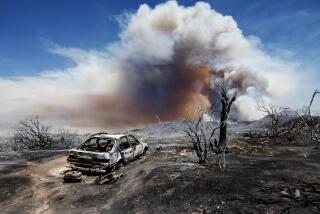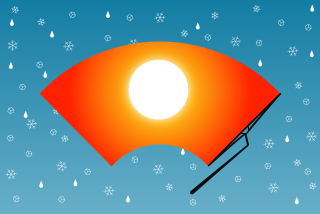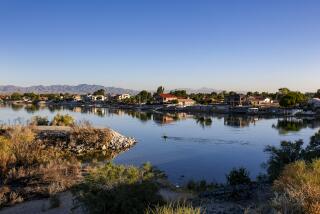Wet, Cold July Was in the Forecast
- Share via
Friday will not be remembered as a red-letter day by the San Diego Convention & Visitors Bureau.
For starters, the National Weather Service recorded 0.03 of an inch of rain, making Friday the second-wettest July 17 since records began 115 years ago, in 1872. Record precipitation for the date was 0.12 of an inch in 1912. Normal rainfall for the entire month is 0.01 of an inch.
If that weren’t enough, the high of 67 degrees Friday was the second-coldest July 17 on record, exceeded only in its coolness by a 66-degree reading in 1894. The normal highs for this time of year are in the mid-70s.
All of this was predicted earlier this year, albeit in a general way, by one of the nation’s pioneer researchers in long-range weather forecasting.
Proud of Forecast
“We feel pretty good that the broad pattern of weather (predicted for the summer) is being shown,” said Jerome Namias, head of the climate research group at UC San Diego’s Scripps Institution of Oceanography.
Fortunately for ConVis and the chambers of commerce countywide, Namias only publicizes his annual winter season forecasts, or the National Weather Service might have gotten even more phone calls than it did on Friday.
“We got a lot of telephone complaints,” said Wilbur Shigehara, chief meteorologist in San Diego, “especially from younger women wanting to come to the beach to sunbathe or take kids on a picnic or to the zoo.
“But then again, there are some residents who enjoy this.”
For the majority of San Diegans who enjoy the sun, however, the weather will gradually be turning nicer beginning today, with sunny afternoons and warmer temperatures through the middle of next week, Shigehara said.
But he and a lot of other meteorologists are still trying to understand exactly why weather conditions along the West Coast this week resembled seasonal patterns much more typical of winter.
Strong upper-level winds of the jet stream swung down the coast from the Gulf of Alaska, bringing in cool air and storm-like weather from a low-pressure system centered off Oregon. There were snow flurries in the Cascades.
“We had computer indications that this would develop but they did not show the situation to be this cold,” Shigehara said of computer predictions that show weather patterns as much as two weeks in advance. “But in general, the computers were right.”
As a result, the normal marine air layer along the coast during night and early morning deepened considerably. That cool air layer is normally drawn ashore by hot air in the desert but burns off quickly during the day.
Namias of Scripps said the weather is an aberration from normal summer season characteristics. The upper-level winds from the Gulf of Alaska have been stronger than usual and have accentuated a low pressure system off Oregon that is deeper than usual, extending up to 30,000 feet. A high pressure system west of the low-pressure trough helps create a wave-like situation in the atmosphere that results in dropping the jet stream much farther south than normal.
“That is more characteristic of the cooler seasons, and usually storms (this time of year) migrate farther north,” Namias said.
Namias predicted just such a general pattern before the summer started.
“I did predict a lot of heat in the eastern half of the United States and predicted a lot of cool weather in the far West, and that has periodically occurred, although not enough as yet to prove my forecast, since there was some heat in the far West in June,” Namias said.
“But I did predict below-normal temperatures for the Los Angeles and San Diego areas with a lot of indications of clouds and even some rain, though not a lot, so I feel pretty good . . . although summer isn’t over yet.”
Namias bases his interpretations primarily on the interaction of surface water temperatures and wind patterns in the North Pacific, relying on the ocean temperatures as indicators of changes over North America.
“That is my theory, that these things are in large part forced by surface conditions in the Pacific,” he said, “but it’s not the easiest thing in the world to prove.”
More to Read
Sign up for Essential California
The most important California stories and recommendations in your inbox every morning.
You may occasionally receive promotional content from the Los Angeles Times.













